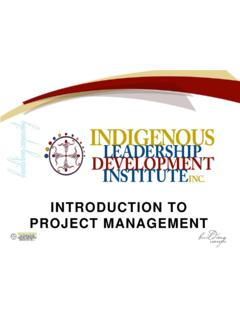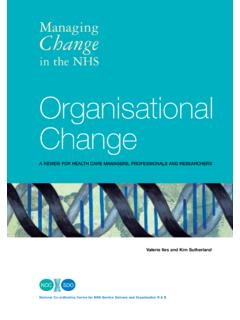Transcription of Tasmanian Government Project Management Guidelines
1 D e p a r t m e n t o f P r e m i e r a n d C a b i n e t Tasmanian Government Project Management Guidelines Version (July 2011) Publisher and Editor: Office of eGovernment Department of Premier and Cabinet Tasmania Acknowledgments: Project Managers, State Government of Tasmania Members of the former Tasmanian Government Inter Agency Steering Committee Tasmanian Government Project Management Advisory Committee Current and former staff, Office of eGovernment Department of Premier and Cabinet John R. Smyrk, Sigma Management Science Pty Ltd Other influencers: Australian Bureau of Statistics The Thomsett Company DISCLAIMER This material has been prepared for use by Tasmanian Government Agencies and Instrumentalities. It follows that this material should not be relied on by any other person. Furthermore, to the extent that this material is relied on , the Crown in Right of the State of Tasmania gives no warranty as to the accuracy or correctness of the material or for any advice given or for omissions from the material.
2 Users rely on the material at their own risk . ISBN 978 0 7246 5593 X Tasmanian Government Project Management Guidelines Page 3 PrefaceThe Tasmanian Government Project Management Guidelines provide a structured approach to managing projects within the Tasmanian State Service. They provide an overview of the essential components of Project Management methodology and identify eleven Key Elements that should be applied throughout the Project lifecycle. While these Guidelines are relevant to all projects regardless of their size and complexity, how extensively they are applied will require a level of judgement. The Guidelines provide a starting point to establish the Project context, gain formal agreement to proceed and for considering the Project Management methodology that is relevant to the Project . The Guidelines are intended to provide guidance. They build on the collective knowledge and experience of Project managers working within the Tasmanian State Service. They describe ongoing research into better practice, insights gathered through formal review and contributions from current and former staff of the Office of eGovernment, Department of Premier and Cabinet (DPAC), members of the former Inter Agency Steering Committee, the Project Management Advisory Committee and feedback from numerous Project teams, Project sponsors and Project steering committees across all agencies.
3 The Guidelines also include invaluable advice and contributions from John Smyrk from Sigma Management Science Pty Ltd. These contributions have allowed the Guidelines and the Tasmanian Government approach to Project Management to continuously develop and improve. The Guidelines also reflect key learnings from major projects including whole-of- Government , whole-of-agency and cross-agency projects that involve significant business change. These key learnings include the Management of large programs of projects and a move towards adopting Project Portfolio Management practices within several agencies. The continuing evolution of these Guidelines is evidence of the Tasmanian Government s longstanding commitment to the application of better practice with regard to Project Management . How to use these Guidelines The Guidelines are presented in two sections: Section 1 provides an overview of projects. It describes the characteristics of a Project , why projects need to be managed and outlines the Project Management lifecycle.
4 It also describes the range of Project Management documentation that is available and how and when it should be used. Section 1 also provides a brief introduction to the eleven Key Elements of Project Management . Section 2 describes the eleven Key Elements of Project Management in detail with practical information on how they should be applied throughout the Project lifecycle. Each Key Element is discussed separately, with a description of how it should be considered and applied, regardless of the size or complexity of a Project Tasmanian Government Project Management Guidelines Page 4 The eleven Key Elements presented in these Guidelines reflect the areas covered by A Guide to the Project Management Body of Knowledge (PMBOK Guide1), but they also include elements arising from ongoing collaboration with practising Project managers within the Tasmanian State Service. As such, they form the basis of the Tasmanian Government Project Management Framework (TGPMF) which is available at Development history Version of the Tasmanian Government Project Management Guidelines was published in September 1996.
5 In version , all sections were revised in the light of ongoing feedback and consultation with practising Project Managers, including: The capturing of learnings from several major whole-of- Government and cross-Agency projects A major update to the content on outcome realisation planning, including inclusion of outcome realisation planning in the Project Initiation Phase Editorial, layout, style and consistency review of the document. These enhancements reflect the continuing Project Management maturity within the Tasmanian Government . 1 Project Management Institute, A Guide to the Project Management Body of Knowledge (PMBOK Guide) Fourth Edition, 2008, Tasmanian Government Project Management Guidelines Page 5 Table of Contents Preface 3 Section 1 Project Management the basics .. 9 1. What is a Project ? .. 9 2. What are the essential characteristics of a Project ? .. 9 3. What is Project Management and why do we need it?
6 10 4. The life of a Project Project phases ..11 5. Key Elements a brief explanation ..12 6. Key Elements in the Project life ..16 7. Determining Project 8. Project Management documentation ..18 9. Tips from Project managers: ..19 Section 2 The 11 Key Elements of Project Management .. 21 Element 1 Planning and scoping .. 22 What is planning and scoping? ..22 Planning and scoping a Project ..22 Documenting Project scope ..28 Planning and managing Project activities ..34 Tips from Project managers: ..36 Element 2 Governance .. 37 What is Project governance? ..37 Ensuring effective Project governance ..37 The roles and functions of a Project Steering Committee ..49 Project Steering Committee meetings ..52 Project Management governance models ..52 Governance of interlinked projects (program Management )..54 Project Portfolio Management ..57 Post- Project governance ..58 Tips from Project managers: ..60 Element 3 Outcome Realisation (including organisational change Management ).
7 61 What is Outcome Realisation? ..61 Planning for Outcome Realisation ..61 Organisational change Management ..65 Outcome Realisation planning documents ..69 Element 4 Stakeholder engagement .. 71 What is stakeholder engagement? ..71 Classifying Stakeholder Analysis ..76 Communication strategies ..78 Managing stakeholder expectations ..83 The role of the Project Sponsor and champions in engaging stakeholders ..84 Maintaining stakeholder commitment ..85 Communicating with Project opponents ..86 The difference between communication and marketing ..87 Tips from Project managers: ..88 Tasmanian Government Project Management Guidelines Page 6 Element 5 Risk Management .. 89 What is risk Management ? ..89 Risk Management through the life of a Project ..90 The main elements of risk Management ..90 Roles and responsibilities .. 102 Risk Management documentation .. 103 Tips from Project managers: .. 105 Element 6 Issues Management .. 106 What is issues Management ?
8 106 Monitoring issues .. 106 Issues Management flowchart .. 107 Project Issues Register Structure .. 108 Tips from Project managers: .. 110 Element 7 Resource Management .. 111 What is resource Management ? .. 111 Managing human resources .. 111 Managing financial resources .. 113 Contract Management .. 114 Managing physical resources .. 115 Managing information resources .. 115 Tips from Project managers: .. 117 Element 8 Quality Management .. 118 What is quality Management ? .. 118 Planning to achieve quality results .. 118 Developing a Quality Management Plan .. 122 Quality improvement .. 126 Tips from Project managers: .. 126 Element 9 Status reporting .. 127 What is status reporting? .. 127 Purpose of the Project Status Report .. 127 Developing a Project Status Report .. 128 Traffic light reporting: indicators of Project health .. 129 Frequency of reporting .. 130 Element 10 Project review and evaluation .. 132 What is Project review and evaluation?
9 132 Project review: assessing Project performance .. 132 Project evaluation: assessing Project success .. 137 The role of the Project Sponsor and Project Steering Committee in achieving Project success .. 141 Learning from Project failure .. 142 Element 11 Project closure .. 144 What is Project closure? .. 144 Formal Project closure .. 144 Project closure steps .. 145 A two-stage approach to closure .. 147 The difference between evaluation and closure .. 151 Closing an incomplete Project .. 152 Closing an unsuccessful Project .. 153 Tips from Project managers: .. 155 Tasmanian Government Project Management Guidelines Page 7 Appendix 1 Project Management Glossary .. 156 Appendix 2 Governance Roles .. 166 Appendix 3 Steering Not Rowing: A Charter for Project Steering Committees and Their 175 Appendix 4 A Charter for Project Management Quality Advisory Consultants .. 177 Appendix 5 A Charter for Project Management Quality Review Consultants.
10 178 Appendix 6 Project Management Documentation .. 179 INITIATE phase documents .. 179 MANAGE phase documents .. 181 FINALISE phase documents .. 189 Tasmanian Government Project Management Guidelines Page 9 Section 1 Project Management the basics This section includes: 1. What is a Project ? 2. What are the essential characteristics of a Project ? 3. What is Project Management and why do we need it? 4. The life of a Project Project phases 5. Key Elements a brief explanation 6. Key Elements in the Project lifecycle 7. Determining Project size 8. Project Management documentation 9. Tips from Project managers Terms used in this section can be found in Appendix 1 Project Management Glossary 1. What is a Project ? A Project is a group of interrelated activities that are planned and then executed in a certain sequence to create a unique product or service to defined quality criteria within a specific timeframe, in order to achieve planned and agreed outcomes. Projects are often critical components of an organisation s business strategy, or relate directly to policies and initiatives of the Government .






